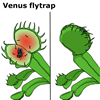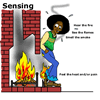 Some automated robots nowadays are very lifelike in their actions
and abilities: they can move, work and respond to light and sound. Would
a scientist say they are "living"?
Some automated robots nowadays are very lifelike in their actions
and abilities: they can move, work and respond to light and sound. Would
a scientist say they are "living"?
The major difference between living things and non-living things is that all living things (organisms) are made up of one or more cells. These basic units can perform all processes associated with life. Living things all show the following seven main life functions at some time:
Movement
 This allows them to change their position in their environment to
obtain essential requirements such as water, air and food as well as to
protect themselves, or locate a mate.
This allows them to change their position in their environment to
obtain essential requirements such as water, air and food as well as to
protect themselves, or locate a mate.
Plants are slower and more limited in their movement, though a fly caught by an insectivorous (insect eating) plant might disagree!
Reproduction
 Unlike a stone, living things cannot continue indefinitely, so they
need to be able to create similar organisms to themselves to survive through
time. Extinction may result if reproduction is not successful.
Unlike a stone, living things cannot continue indefinitely, so they
need to be able to create similar organisms to themselves to survive through
time. Extinction may result if reproduction is not successful.
Sensitivity
 It
is important that living things can sense, and respond to, changing factors
in their environment. Information taken in through the senses is processed
to allow a response which helps it to survive. For example, if you are
too close to a fire, you usually back away to prevent yourself being burnt.
You know whether you are too close by sensing with your eyes (you see
flames), heat detectors in the skin pick up warmth, your nose picks up
the smell of burning and your ears hear the crackling fire.
It
is important that living things can sense, and respond to, changing factors
in their environment. Information taken in through the senses is processed
to allow a response which helps it to survive. For example, if you are
too close to a fire, you usually back away to prevent yourself being burnt.
You know whether you are too close by sensing with your eyes (you see
flames), heat detectors in the skin pick up warmth, your nose picks up
the smell of burning and your ears hear the crackling fire.
Similarly, plants can sense and respond to light, water and gravity.
Growth
This involves both an increase in size, and repair of damaged parts. Unlike
crystals which grow only on their outer edges, living things take in nutrients,
change them and then use them as building blocks wherever required throughout
the organism.
Respiration
All life processes require energy. The function of respiration is to release
energy from food for use by the organism. This process usually requires
oxygen, but not always. Plants differ from animals by being able to produce
their own food, using it later as an energy source.
Elimination
All life functions create wastes which must be removed from the organism
or these would build up and become poisonous. In humans, these include
carbon dioxide (removed via the lungs), excess salts and water (removed
through the skin and the kidneys), and unused waste food (removed as faeces).
Excess heat is also continuously lost from the body through the skin.
Nutrition
In all living things, there is a continual need to take in food for the
nutrients which are required for growth, as well as energy.
The acronym MRS GREN makes these seven characteristics easier to remember.
Two other terms often confused in discussions of "living" are
"dead" and "non-living".
"DEAD" implies that the object was once living.
| Copyright owned by the State of Victoria (Department of Education and Early Childhood Development). Used with Permission. |
|
|||||||||||||||||||||||